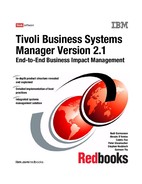
372 Tivoli Business Systems Manager Version 2.1: End-to-End Business Impact Management
Figure 11-19 illustrates a discovered CICSPlex environment topology view.
Figure 11-19 CICSPlex SM CICS Topology display
11.6 Tivoli Workload Scheduler for z/OS
The following section describes the configuration steps for Tivoli Workload
Scheduler for z/OS data source integration into IBM Tivoli Business Systems
Manager.
11.6.1 Concept
The discovery of TWS for z/OS is processed from the Extend Daily Plan job
report. This report must be downloaded to the IBM Tivoli Business Systems
Manager database server and loaded using the OPCParseDailyPlan.ksh
program.

Chapter 11. z/OS data feeds and discovery 373
Startup and completion events for each TWS for z/OS job with the external
monitoring flag set to On are sent to IBM Tivoli Business Systems Manager
through the AOPEDI interface.
11.6.2 Integration setup
Several tasks must be performed for setting up the integration:
? “Disabling the old interface” on page 373
? “Configuring Tivoli Workload Scheduler for z/OS” on page 374
? “Preparing the TBSM database” on page 375
Disabling the old interface
If you previously integrated Tivoli OPC Version 2.2 or Version 2.3 into IBM Tivoli
Business Systems Manager, you must disable any WTO and user exit 7
processing that was set up for these versions. This is the procedure:
1. Change the OPC initialization parameter as shown in Example 11-7. Remove
the commented portion. Remove the WTO alerts from the ALERTS
initialization statement in OPC and disable the call to exit 07 EQQUX007.
Example 11-7 OPC initialization parameter changes
ALERTS GENALERT(OPCERROR)
MLOG (ERROROPER)
# WTO (DURATION
# ERROROPER
# LATEOPER
# OPCERROR
# QLIMEXCEED
# RESCONT)
. . .
#EXITS CALL07(YES)
EXITS CALL07(NO)
2. Remove the IBM Tivoli Business Systems Manager version of EQQUX007
from any library in LNKLST, or concatenated in the TWS for z/OS’s STEPLIB
DD statement.

374 Tivoli Business Systems Manager Version 2.1: End-to-End Business Impact Management
Configuring Tivoli Workload Scheduler for z/OS
To implement the new interface:
1. Add this EXTMON parameter to the OPCOPTS statement in your TWS
initialization member:
OPCOPTS EXTMON(YES)
2. The IBM Tivoli Business Systems Manager module AOPEDI must be made
available to either the tracker or controller procedures. Either concatenate
hlq.SGTMMODS into the STEPLIB DD statement of the tracker or controller
procedure, or copy hlq.SGTMMODS(AOPEDI) into the TWS load module
library EQQ.SEQQLMD0.
3. To enable IBM Tivoli Business Systems Manager monitoring of a job, you
must set the External Monitor job option of an operation to YES(Y). This can
be done using the ISPF panels for either job as shown in Figure 11-20. A
mass update also may be performed.
Figure 11-20 Detailed operation information
------------------- BROWSING DETAILED OPERATION INFORMATION -------------------
Command ===>
Application : FXXXDWPARMUPDATE Upd parms on UNIX FTAs
Operation : DUMY 5 Update parms. on F100
Occurrence token : B873886335D1A664
Jobname and Jobid : DUMMYSTR
Reader date and time :
Status : Completed
on Work Station :
Job or Sysout class : Auto submit: Yes Hold/release : Yes
Form number : Time depend: No Suppress late: No
Priority : 5 Rerouteable: Restartable :
Deadline WTO : No Ext monitor: Yes
WLM Critical : No Policy :
Date and time for : Planned Actual
Input arrival : 02/10/30 09.00 02/10/30 12.33
Start :
End : 02/10/30 12.33 User field:
Deadline : 02/10/30 18.00
Duration : 00.00.30 00.00.00
Latest start : 02/10/30 17.58
Resources : Parallel servers R1 R2 Special resources
Required number : 1 0 0 0

Chapter 11. z/OS data feeds and discovery 375
Preparing the TBSM database
Preparing the TBSM database requires the following steps:
? Insert the BATCH SCHEDULE SET object on the console.
? Define the mapping of batch schedules.
In this section, we define which applications should be monitored and how these
applications should be grouped. Perform the following steps:
1. Define the dynamic path where you want to put the batch job objects from
TWS. Our definition was created in the OPC_Class_Definition.sqi file shown
in Example 11-8.
Example 11-8 Dynamic object path for Tivoli LOB
include(BusinessObject.sqi)
BEGIN_DYNA_OBJ_PATH(OPC, Group all OPC backup processes)
DYNA_OBJ_PATH(BUSC,BUSC)
DYNA_OBJ_PATH(ENT,ITSO)
DYNA_OBJ_PATH(COMP,Poughkeepsie)
DYNA_OBJ_PATH(BCYS,BACKUPSYSTMS, OPC backup applications for Backup
Batch)
DYNA_OBJ_PATH(BTCY,BACKUPSYSTMS, OPC backup applications for Backup
Batch)
END_DYNA_OBJ_PATH(OPC)
BEGIN_DYNA_OBJ_PATH(OPC LOB, Group all OPC LOBs)
DYNA_OBJ_PATH(LOBC,LOBC)
DYNA_OBJ_PATH(LOB,OPC Applications)
DYNA_OBJ_PATH(BCYS,BACKUPSYSTMS, OPC backup applications for His Company
Backup Batch)
DYNA_OBJ_PATH(BTCY,BACKUPSYSTMS, OPC backup applications for His
Company Backup Batch)
END_DYNA_OBJ_PATH(OPC LOB)
2. Define the file selection filter for the individual batch jobs that will be matched
with the dynamic path that we defined. Our definition was created in the
OPC_Appl_Definition.sqi file shown in Example 11-9.
Example 11-9 Pattern matching for OPC dynamic path
include(BusinessObject.sqi)
OPC_APP_PATTERN(OPC, ITSO.BATCH, %SAMPLE[A-Z]%, %, %)
OPC_APP_PATTERN(OPC LOB, ITSO.BATCH, %SAMPLE[A-Z]%, %, %)
3. Pre-process the sqi file using the clsql script and run the resulting sql files.
We used the shell script shown in Example 11-10 on page 376 to perform this
function.
..................Content has been hidden....................
You can't read the all page of ebook, please click here login for view all page.
